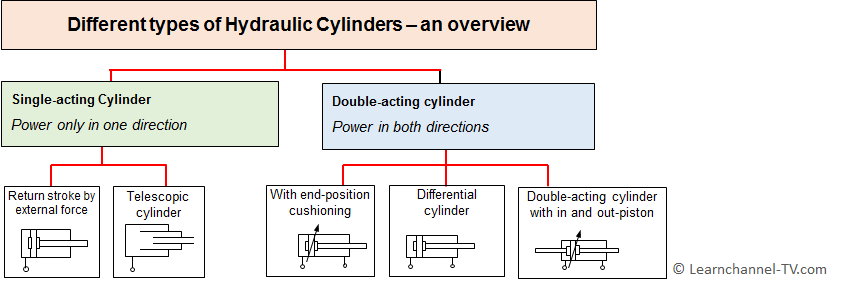Home ⇒ Overview Courses ⇒ Hydraulics ⇒ Hydraulic cylinder
Diferent types of hydraulic cylinder
Hydraulic cylinders convert hydraulic energy into mechanical work. Normally they generate a linear movement. For many tasks of hydraulic cylinders you can get a choice:

Different types of Hydraulic Cylinders – an overview
Single-acting cylinders have only a single port and are hydraulically actuated in only one direction. The hydraulic oil is drained back into the reservoir. The piston retracts, either by the weight of a load or by an additional mechanical force, e.g. feather.
Double-acting hydraulic cylinders have two ports. These cylinders provide piston force in both directions, precise piston control in either direction. Double-acting cylinders are ideal for jobs that require controlled traction.
Cylinders with in and out piston deliver the same speeds and the same forces in both directions, since the effective areas are identical on both sides.
The telescopic cylinder can be single or double-acting. This cylinder consists of a series of individual cylinders nested within one another. This type of cylinder is relatively small when retracted. However, a relatively large stroke can be realized when all individual cylinders are extended.
Piston damper
To avoid that the piston does not drive at full speed against the end stop, a cushioning is required.

piston damper
Functioning: (1)A damping piece closes, just before reaching the end position, the discharge outlet. (2) The oil is forced to make its way through the small hole with an adjustable throttle screw. The piston thus runs against an oil cushion and gets an end position damping.
Piston speed
The volumetric flow rate Q, which flows into the cylinder, causes the piston to extend or retract. The piston velocity v depends on the volume flow Q and the effective piston area A.
v = Q v piston speed in m/s
A Q volumetric flow rate in l/min
A effective piston area

piston speed
Efficiency
The efficiency of a cylinder is determined mainly by friction. Today's seals have low leakage losses, implied that they are new. With increasing operating time, however, the leakage will increase and thus the overall efficiency decreases.
Exercises for this chapter Hydraulic cylinder
The pressure of a hydraulic system is limited to 100 bar by a pressure relief valve. As an actor, a cylinder with d1 = 80 mm and d2 = 35 mm is used. The pump delivers a flow rate Q = 20 liters / min. The efficiency of the cylinder is 0.85.
To calculate: The maximum compressive force F1 of the extending cylinder b) the maximum tensile force F2 of the retracting cylinder c) the piston velocity va during extension and d) piston speed ve during retraction.
Solution for a):
Fcompr. = pe * Apiston * ɳCyl Apiston = ᴫ/4 d12 cm2 = 50,265 cm2
Fcompr. = 1000 N/cm2 * 50,27cm2 * 0,85 = 42,73 kN
Solution for b):
Ftraction = pe * AAnular * ɳCyl AAnular = ᴫ/4 (dpiston2 – drod2) = ᴫ/4 (64cm2 – 12,25cm2) = 40,64 cm2
Ftraction = 1000 N/cm2 * 40,64 cm2 * 0,85 = 34,54 kN
Solution for c):
va = Qe = 20*10-3m3/60s = 0,066 m/s
APiston 50,265*10-4m2
Solution for d):
ve = Qe = 20*10-3m3/60s = 0,082 m/s
AAnular 40,64*10-4m2

